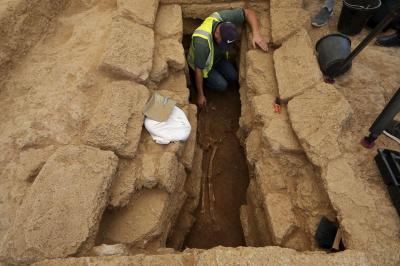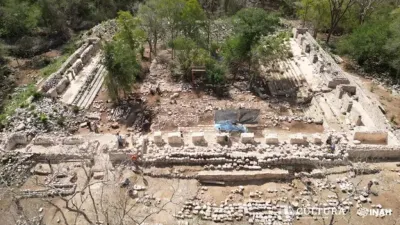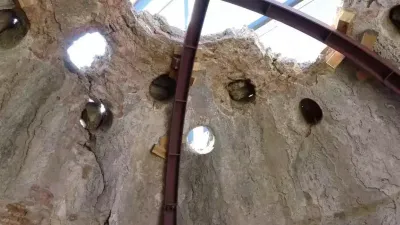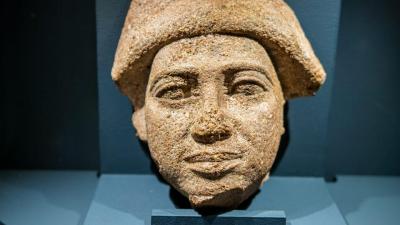INSTITUT SUPERIEUR D'ANTHROPOLOGIE
INSTITUT OF ANTHROPOLOGY
COURS ONLINE – COURS A DISTANCE
INSCRIPTIONS : SEPTEMBRE 2023
REGISTER NOW
PALESTINE –  Gaza Strip - Palestinian workers in the Gaza Strip have found dozens of ancient graves, including two sarcophagi made of lead, in a Roman-era cemetery — a site dating back some 2,000 years that archaeologists describe as the largest cemetery discovered in Gaza. Rene Elter, a French archaeologist leading the dig, said researchers have studied over 100 of the graves. “All of these tombs have almost already been excavated and have revealed a huge amount of information about the cultural material and also about the state of health of the population and the pathologies from which this population may have suffered,” Elter pointed to the sarcophagi made of lead — one featuring ornate grape leaves, the other with images of dolphins — as exceptional finds.
Gaza Strip - Palestinian workers in the Gaza Strip have found dozens of ancient graves, including two sarcophagi made of lead, in a Roman-era cemetery — a site dating back some 2,000 years that archaeologists describe as the largest cemetery discovered in Gaza. Rene Elter, a French archaeologist leading the dig, said researchers have studied over 100 of the graves. “All of these tombs have almost already been excavated and have revealed a huge amount of information about the cultural material and also about the state of health of the population and the pathologies from which this population may have suffered,” Elter pointed to the sarcophagi made of lead — one featuring ornate grape leaves, the other with images of dolphins — as exceptional finds.
Archeology: Archaeologists unearth the largest cemetery ever discovered in Gaza and find rare lead sarcophogi | International | EL PAÍS English (elpais.com)
ITALIE –  Paestum - A German archeologist has allegedly solved the mystery of the ancient Greek Paestum swimmer. The debate has endured for years about the possible interpretations of the fresco. Yet Tonio Höschler, a Professor Emeritus of Classical Archeology at the Ruprecht University Karl of Heidelberg, has perhaps found the simplest and most probable of all meanings. Paestum was an important Ancient Greek colony around 60 miles (95km) away from today’s Naples, Italy and is famous for the fresco of a young male diving into an unknown sea engraved upon the lid of his tomb. However, over the years since it was found, historians and archeologists alike have scratched their heads in puzzlement as the imagery of a youth in his prime was not what one associated normally with funerary. The Swimmer of Paestum is Hölscher’s attempt to address questions surrounding the fresco portraying the naked diver by disassociating it from interpretations involving symbolism. What he did in his work instead was propose something equally breathtaking in its simplicity; namely, that the scene depicts one that was real once upon a time.“Young people were seen as the hope of society…in the universe of Ancient Greece, beauty was not only a physical trait, but also a spiritual and ethical one” Höschler explained in relation to his work. “The healthy and strong body is beautiful and an instrument of human excellence.” It is this context then that the specialist in the Greek and Roman monuments and scholar in Greek mythological imagery and city-planning interpreted the work. Previous scholars, for example, have focused on metaphorical interpretations that linked the ancient tuffatore – a person who dives –to Pythagorean tradition, Orphics about the Beyond, salvationist ideas and metempsychosis. Others look upon it as an existential symbol of the leap from life to death or the Ancient Greek ordeal self-punishment through suicide. There has even been arguments that the boy was Etruscan rather than Greek. Still, the uncertainty did taken away from the tomb’s magic. The filmmaker Claude Lanzmann wrote an impassioned essay about it after visiting with Simone de Beauvoir and Satre. The ‘dive plunger’ he called him, declaring “I would never have imagined being touched in the middle of the heart, upset in the depths of myself, as I was the day it appeared to me, perfect arc, as if it were endlessly plunging into the space between life and death.” Italian archeologist Marco Napoli discovered the tomb of the swimmer of Paestum in 1968 in Salerno in Italy’s southern province. There was no indication of whose tomb it was as there were no inscriptions. Furthermore, only inconsequential objects such as a remnant of a lyre and a small tortoise shell were found. The bones had evidently disintegrated long before, making it impossible to analyse any remains. The handsomeness of the tomb was undisputed, nonetheless. Five large stone slabs housed the almost barren space. On them, however, were sensuous scenes of a banquet, male couples, and a symposium. Yet the one on the ceiling was the most astounding and astonishing of all. A large, stunning fresco of a naked young man soaring from a cliff into an empty space.“The common opinion – until now – was that the young man didn’t simply jump into the sea, but made a transition from life to death. The sea was eternity” the German scholar states. “There was a general consensus surrounding the interpretation.” Höschler however is confident about his own understanding of the figure. Namely, that “this image was simply depicting a jump has taken time to gain ground, but slowly has convinced more scholars.” The reason, it seems, is because many academics seem to believe that Ancient Greeks feared the sea. However, that is an idea that the Professor of Classical Archeology also renounces. In his opinion, swimming was also part of Ancient Greek life.Another assertion Tonio Höschler makes is that the scene depicts an ancient rite of passage. In his words: “The jump portrays a young man – in transition to adulthood – demonstrating his athletic ability and courage by lounging himself into the water” “The dive,” he further asserts “is therefore part of a rite of passage…but it’s not a metaphor.” The Professor Emeritus stresses the diver’s tan skin and his technique as proof. He also describes the sensuality and beauty of the scene and its projection of fundamental harmony. Whether other academics will agree with the scholar is yet to be seen. Nevertheless, it does offer a new perspective on who the young man was and why we still find him so intriguing. It is for that reason as well that it is one of the most important Ancient Greek archeological sites.
Paestum - A German archeologist has allegedly solved the mystery of the ancient Greek Paestum swimmer. The debate has endured for years about the possible interpretations of the fresco. Yet Tonio Höschler, a Professor Emeritus of Classical Archeology at the Ruprecht University Karl of Heidelberg, has perhaps found the simplest and most probable of all meanings. Paestum was an important Ancient Greek colony around 60 miles (95km) away from today’s Naples, Italy and is famous for the fresco of a young male diving into an unknown sea engraved upon the lid of his tomb. However, over the years since it was found, historians and archeologists alike have scratched their heads in puzzlement as the imagery of a youth in his prime was not what one associated normally with funerary. The Swimmer of Paestum is Hölscher’s attempt to address questions surrounding the fresco portraying the naked diver by disassociating it from interpretations involving symbolism. What he did in his work instead was propose something equally breathtaking in its simplicity; namely, that the scene depicts one that was real once upon a time.“Young people were seen as the hope of society…in the universe of Ancient Greece, beauty was not only a physical trait, but also a spiritual and ethical one” Höschler explained in relation to his work. “The healthy and strong body is beautiful and an instrument of human excellence.” It is this context then that the specialist in the Greek and Roman monuments and scholar in Greek mythological imagery and city-planning interpreted the work. Previous scholars, for example, have focused on metaphorical interpretations that linked the ancient tuffatore – a person who dives –to Pythagorean tradition, Orphics about the Beyond, salvationist ideas and metempsychosis. Others look upon it as an existential symbol of the leap from life to death or the Ancient Greek ordeal self-punishment through suicide. There has even been arguments that the boy was Etruscan rather than Greek. Still, the uncertainty did taken away from the tomb’s magic. The filmmaker Claude Lanzmann wrote an impassioned essay about it after visiting with Simone de Beauvoir and Satre. The ‘dive plunger’ he called him, declaring “I would never have imagined being touched in the middle of the heart, upset in the depths of myself, as I was the day it appeared to me, perfect arc, as if it were endlessly plunging into the space between life and death.” Italian archeologist Marco Napoli discovered the tomb of the swimmer of Paestum in 1968 in Salerno in Italy’s southern province. There was no indication of whose tomb it was as there were no inscriptions. Furthermore, only inconsequential objects such as a remnant of a lyre and a small tortoise shell were found. The bones had evidently disintegrated long before, making it impossible to analyse any remains. The handsomeness of the tomb was undisputed, nonetheless. Five large stone slabs housed the almost barren space. On them, however, were sensuous scenes of a banquet, male couples, and a symposium. Yet the one on the ceiling was the most astounding and astonishing of all. A large, stunning fresco of a naked young man soaring from a cliff into an empty space.“The common opinion – until now – was that the young man didn’t simply jump into the sea, but made a transition from life to death. The sea was eternity” the German scholar states. “There was a general consensus surrounding the interpretation.” Höschler however is confident about his own understanding of the figure. Namely, that “this image was simply depicting a jump has taken time to gain ground, but slowly has convinced more scholars.” The reason, it seems, is because many academics seem to believe that Ancient Greeks feared the sea. However, that is an idea that the Professor of Classical Archeology also renounces. In his opinion, swimming was also part of Ancient Greek life.Another assertion Tonio Höschler makes is that the scene depicts an ancient rite of passage. In his words: “The jump portrays a young man – in transition to adulthood – demonstrating his athletic ability and courage by lounging himself into the water” “The dive,” he further asserts “is therefore part of a rite of passage…but it’s not a metaphor.” The Professor Emeritus stresses the diver’s tan skin and his technique as proof. He also describes the sensuality and beauty of the scene and its projection of fundamental harmony. Whether other academics will agree with the scholar is yet to be seen. Nevertheless, it does offer a new perspective on who the young man was and why we still find him so intriguing. It is for that reason as well that it is one of the most important Ancient Greek archeological sites.
Has the Mystery of the Ancient Greek Paestum Swimmer been Solved? (greekreporter.com)
GRECE – 
 SISI - An intact skeleton of a woman lying next to a stunning necklace and other important artifacts from the Early Minoan era (circa 2,600 BC), were unearthed recently at the archaeological site of Sisi on Crete. A box-shaped grave belonging to the post-Minoan era containing an almost intact skeleton of a woman was found. A copper mirror with an ivory handle, dress pins made of copper, and a necklace with fifteen olive-shaped, golden beads and fifteen smaller golden beads were also found within the woman’s grave. These types of graves are rare on Crete and are usually only found in Knossos and Chania. Further excavations have revealed a decorated floor, constructed with a high-quality mortar, and a well-made 33-meter (109-foot) long clay drainage pipe, the Ministry said.
SISI - An intact skeleton of a woman lying next to a stunning necklace and other important artifacts from the Early Minoan era (circa 2,600 BC), were unearthed recently at the archaeological site of Sisi on Crete. A box-shaped grave belonging to the post-Minoan era containing an almost intact skeleton of a woman was found. A copper mirror with an ivory handle, dress pins made of copper, and a necklace with fifteen olive-shaped, golden beads and fifteen smaller golden beads were also found within the woman’s grave. These types of graves are rare on Crete and are usually only found in Knossos and Chania. Further excavations have revealed a decorated floor, constructed with a high-quality mortar, and a well-made 33-meter (109-foot) long clay drainage pipe, the Ministry said.
Ancient Skeleton and Stunning Necklace Unearthed on Greece's Crete (greekreporter.com)
MEXIQUE –  Kabah - Mexican National Institute of Anthropology and History (INAH) archaeologists have discovered a palace at an ancient Maya city in southeastern Mexico that shares characteristics with ruins in neighboring Guatemala, which could point to an “important” period of migration thousands of years ago. The palace was found in the archaeological zone of Kabah—a pre-Hispanic settlement located in the Puuc region of Yucatán state, south of the modern city of Mérida. The newly discovered palace has a main facade composed of a portico with eight pilasters—shallow, decorative columns attached to a wall—and nine openings, as well as an extension of 85 feet, INAH general director Diego Prieto Hernández said. Researchers have named the newly uncovered Maya remains Petenero Palace. Hernández said the quadrangular structure appears to be more than 1,500 years old. The palace was decorated with motifs of feathers, beads and birds that were carved into its architecture. Researchers think the roof of the building was made with a perishable material, such as guano palm, which has not survived. The palace shares some characteristics with Maya remains found in the Petén Department of Guatemala, Hernández said. Until recently, the housing complexes, along with other parts of the ancient city, were covered with vegetation, the INAH statement noted. The city was founded by people who came from the Petén region, which includes Guatemala and Belize, sometime between A.D. 250 and 500, although the precise date of the building’s construction is unknown. Toscano Hernández said the city’s first ruler may have lived in the structures.
Kabah - Mexican National Institute of Anthropology and History (INAH) archaeologists have discovered a palace at an ancient Maya city in southeastern Mexico that shares characteristics with ruins in neighboring Guatemala, which could point to an “important” period of migration thousands of years ago. The palace was found in the archaeological zone of Kabah—a pre-Hispanic settlement located in the Puuc region of Yucatán state, south of the modern city of Mérida. The newly discovered palace has a main facade composed of a portico with eight pilasters—shallow, decorative columns attached to a wall—and nine openings, as well as an extension of 85 feet, INAH general director Diego Prieto Hernández said. Researchers have named the newly uncovered Maya remains Petenero Palace. Hernández said the quadrangular structure appears to be more than 1,500 years old. The palace was decorated with motifs of feathers, beads and birds that were carved into its architecture. Researchers think the roof of the building was made with a perishable material, such as guano palm, which has not survived. The palace shares some characteristics with Maya remains found in the Petén Department of Guatemala, Hernández said. Until recently, the housing complexes, along with other parts of the ancient city, were covered with vegetation, the INAH statement noted. The city was founded by people who came from the Petén region, which includes Guatemala and Belize, sometime between A.D. 250 and 500, although the precise date of the building’s construction is unknown. Toscano Hernández said the city’s first ruler may have lived in the structures.
Archaeologists Discovered 1,500-Year-Old Maya Palace in Mexico - Arkeonews
TURQUIE –  Parion - A 350-year-old Ottoman bath has been unearthed by the excavation team in the ancient city of Parion in Kemer village of the northwestern province of Çanakkale’s Biga district. The ancient city has a history of 2,700 years and was an important port city during the Roman Empire era. Associated Professor Hasan Kasapoğlu, deputy head of Parion excavations, said, "It is the only preserved architectural structure of the Ottoman-Turkish presence in this village, dating back 350 years, hidden among the modern structures in Kemer village, the geography where the ancient city was located in the past." “One of our projects for 2023 was a study on this Ottoman bath in the village of Kemer, which is actually the only structure from the Ottoman period preserved in its current form in the village. There were tombstones of two people in the structure. Studying these two Ottoman-era tombstones, dated to the 1700s, excavation committee members and art historians revealed that two people can be described as the bath keeper and his assistant.” “Then a study was carried out in this structure and it was revealed that this place was a bath. In fact, it can be considered as a new vision project in the sense of Turkish-Islamic Archeology or Ottoman Archaeology. This year, the rubble and garbage pile in the area of this structure was completely cleaned and its interior was consolidated with a temporary steel construction. In the coming years, with the vision of Turkish-Islamic archeology or Ottoman archaeology, we plan to restore this oldest Ottoman-era structure in the village and make it more protected and visitable,” Kasapoğlu said. He said that the Ottoman bath is the most distinctive architectural structure that has been preserved from the Ottoman-Turkish times in the village, which dates back approximately 300-350 years.
Parion - A 350-year-old Ottoman bath has been unearthed by the excavation team in the ancient city of Parion in Kemer village of the northwestern province of Çanakkale’s Biga district. The ancient city has a history of 2,700 years and was an important port city during the Roman Empire era. Associated Professor Hasan Kasapoğlu, deputy head of Parion excavations, said, "It is the only preserved architectural structure of the Ottoman-Turkish presence in this village, dating back 350 years, hidden among the modern structures in Kemer village, the geography where the ancient city was located in the past." “One of our projects for 2023 was a study on this Ottoman bath in the village of Kemer, which is actually the only structure from the Ottoman period preserved in its current form in the village. There were tombstones of two people in the structure. Studying these two Ottoman-era tombstones, dated to the 1700s, excavation committee members and art historians revealed that two people can be described as the bath keeper and his assistant.” “Then a study was carried out in this structure and it was revealed that this place was a bath. In fact, it can be considered as a new vision project in the sense of Turkish-Islamic Archeology or Ottoman Archaeology. This year, the rubble and garbage pile in the area of this structure was completely cleaned and its interior was consolidated with a temporary steel construction. In the coming years, with the vision of Turkish-Islamic archeology or Ottoman archaeology, we plan to restore this oldest Ottoman-era structure in the village and make it more protected and visitable,” Kasapoğlu said. He said that the Ottoman bath is the most distinctive architectural structure that has been preserved from the Ottoman-Turkish times in the village, which dates back approximately 300-350 years.
350-year-old Ottoman bath found in Çanakkale (hurriyetdailynews.com)
FRANCE –  Reims Durocortorum - Archaeologists from France’s National Institute of Preventive Archeology (INRAP) have unearthed an unlooted ancient stone sarcophagus in the vast ancient necropolis on Rue Soussillon in northeastern France. It’s not often that archaeologists find an unlooted Roman sarcophagus, so when it does happen, it becomes the perfect opportunity to learn more about the past. The ancient Durocortorum was the capital of the province of Gaul Belgium and was one of the largest cities in the Roman Empire. The city extended over 600 hectares and was delimited by a powerful wall. It was in the second half of the 19th century, during extension work in Reims, that the contours of this so-called “Augustan” enclosure were highlighted as well as the extra muros necropolises, located around the seven main access routes. (towards Boulogne, Soissons, Paris, Lyon, Trier, Cologne and Bavay). In 22 years of research, 5,000 tombs have been explored and added to the museum’s collections. During the recent excavation, scientists discovered a lime sarcophagus limestone that measures 3.3 feet high, 5.4 feet long, and 2.6 feet wide, with a 1,700-pound lid held in place by iron pegs sealed with lead. The archaeologists first did X-rays on the sarcophagus then used an endoscopic camera. They found a skeleton of a woman inside, alongside a number of other objects, including a mirror. “It’s quite exceptional, it’s the first time that we have found a tomb intact and which has not been looted. It was sealed by eight iron staples, and we were the first to explore it,” Agnès Balmelle, deputy scientific and technical director at Inrap Grand Est, told local news Le Parisien. “The skeleton occupied the entire space of the [5-foot] tank, the individual must have been around 40 years old and had a special status. Four oil lamps were found near her legs and shoulders, as well as a small mirror, an amber ring and a comb,” Balmelle added.
Reims Durocortorum - Archaeologists from France’s National Institute of Preventive Archeology (INRAP) have unearthed an unlooted ancient stone sarcophagus in the vast ancient necropolis on Rue Soussillon in northeastern France. It’s not often that archaeologists find an unlooted Roman sarcophagus, so when it does happen, it becomes the perfect opportunity to learn more about the past. The ancient Durocortorum was the capital of the province of Gaul Belgium and was one of the largest cities in the Roman Empire. The city extended over 600 hectares and was delimited by a powerful wall. It was in the second half of the 19th century, during extension work in Reims, that the contours of this so-called “Augustan” enclosure were highlighted as well as the extra muros necropolises, located around the seven main access routes. (towards Boulogne, Soissons, Paris, Lyon, Trier, Cologne and Bavay). In 22 years of research, 5,000 tombs have been explored and added to the museum’s collections. During the recent excavation, scientists discovered a lime sarcophagus limestone that measures 3.3 feet high, 5.4 feet long, and 2.6 feet wide, with a 1,700-pound lid held in place by iron pegs sealed with lead. The archaeologists first did X-rays on the sarcophagus then used an endoscopic camera. They found a skeleton of a woman inside, alongside a number of other objects, including a mirror. “It’s quite exceptional, it’s the first time that we have found a tomb intact and which has not been looted. It was sealed by eight iron staples, and we were the first to explore it,” Agnès Balmelle, deputy scientific and technical director at Inrap Grand Est, told local news Le Parisien. “The skeleton occupied the entire space of the [5-foot] tank, the individual must have been around 40 years old and had a special status. Four oil lamps were found near her legs and shoulders, as well as a small mirror, an amber ring and a comb,” Balmelle added.
Extraordinary discovery in France: An unlooted 1800-year-old Roman Sarcophagus discovered - Arkeonews
LIBYE – Derma - The devastating floods that swept through Libya earlier this month have revealed new structures at an ancient Greek city near Derna. The Libyan authorities who came to inspect the ancient city and salvage what could be saved unexpectedly found archaeological sites that appeared after the floods subsided. Dr. Ahmed Issa from the Department of Archeology at Omar Al-Mukhtar University said that a national committee consisting of experts should be formed to classify the new archaeological monuments and develop a plan to restore the area.
VIDEO = Floods reveal new parts of ancient Greek city in Libya | News | Independent TV
EGYPTE –  Abousir -Czech Egyptologists working between the pyramid fields of Abusir and Saqqara have announced a major discovery. They have located and explored a lost tomb that belonged to an ancient Egyptian official called Ptahshepses, who lived during the 24th and 25th centuries BC. The tomb of the ancient Egyptian dignitary Ptahshepses was discovered and partially exposed by a French scholar Auguste Mariette almost 160 years ago. Czech Egyptologists discovered the tomb of Ptahshepses with the help of detailed satellite imagery of the area and the study of old maps. The research is still ongoing, and further discoveries will likely be made that will shed new light on his family and his time. But given his political, historical, and religious significance, it is already clear that the tomb is one of the most remarkable discoveries in Egyptian archaeology in recent times.
Abousir -Czech Egyptologists working between the pyramid fields of Abusir and Saqqara have announced a major discovery. They have located and explored a lost tomb that belonged to an ancient Egyptian official called Ptahshepses, who lived during the 24th and 25th centuries BC. The tomb of the ancient Egyptian dignitary Ptahshepses was discovered and partially exposed by a French scholar Auguste Mariette almost 160 years ago. Czech Egyptologists discovered the tomb of Ptahshepses with the help of detailed satellite imagery of the area and the study of old maps. The research is still ongoing, and further discoveries will likely be made that will shed new light on his family and his time. But given his political, historical, and religious significance, it is already clear that the tomb is one of the most remarkable discoveries in Egyptian archaeology in recent times.
Czech archaeologists rediscover famous tomb of Egyptian high official | Radio Prague International
ANGLETERRE –  Piles Hill - A quartz surface – possibly laid deliberately to enhance the setting of a double stone row – has been uncovered during excavations at Piles Hill. The double stone row at Piles Hill spans 850-metres across Ugborough and Harford Moors and aligns east-west, curving slightly upwards like a smile, and is thought to date to the Neolithic/Early Bronze Age. In our last trench we uncovered a paved cobble-like surface made of angular rocks consisting predominantly of white quartz. At first, we thought it was the natural geology but further investigations showed otherwise. We think the rocks were brought to the site and laid there deliberately, possibly to enhance the setting of the stone row.
Piles Hill - A quartz surface – possibly laid deliberately to enhance the setting of a double stone row – has been uncovered during excavations at Piles Hill. The double stone row at Piles Hill spans 850-metres across Ugborough and Harford Moors and aligns east-west, curving slightly upwards like a smile, and is thought to date to the Neolithic/Early Bronze Age. In our last trench we uncovered a paved cobble-like surface made of angular rocks consisting predominantly of white quartz. At first, we thought it was the natural geology but further investigations showed otherwise. We think the rocks were brought to the site and laid there deliberately, possibly to enhance the setting of the stone row.
'Cobble-like surface' unearthed at Neolithic Dartmoor site | teignmouth-today.co.uk